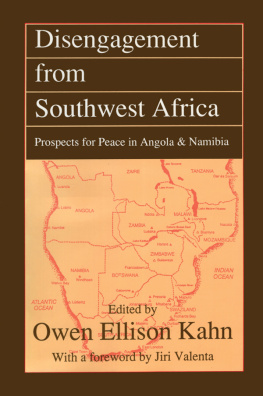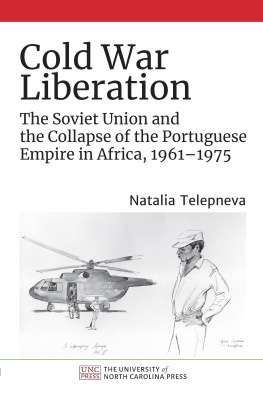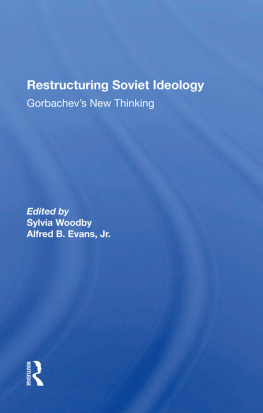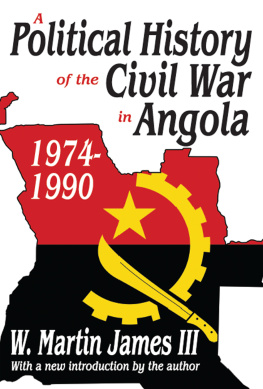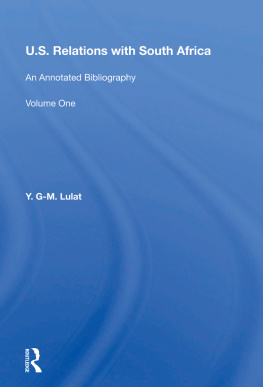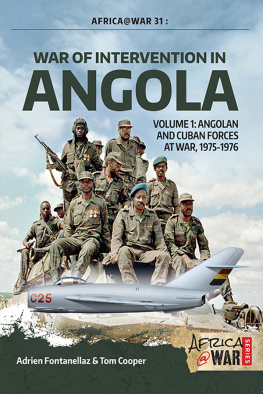First published 1991 by Transaction Publishers
Published 2019 by Routledge
2 Park Square, Milton Park, Abingdon, Oxon OX14 4RN
52 Vanderbilt Avenue, New York, NY 10017
First issued in paperback 2019
Routledge is an imprint of the Taylor & Francis Group, an informa business
Copyright 1991 by Taylor & Francis
All rights reserved. No part of this book may be reprinted or reproduced or utilised in any form or by any electronic, mechanical, or other means, now known or hereafter invented, including photocopying and recording, or in any information storage or retrieval system, without permission in writing from the publishers.
Notice:
Product or corporate names may be trademarks or registered trademarks, and are used only for identification and explanation without intent to infringe.
Library of Congress Catalog Number: 90-10960
Library of Congress Cataloging-in-Publication Data
Disengagement from Southwest Africa: the prospects for peace in Angola
and Namibia/edited by Owen Ellison Kahn.
p. cm.
Papers presented at the Miami conference of the Institute for Soviet and East European Studies, held on December 2021, 1988.
ISBN 0-88738-366-1
1. AngolaForeign relationsSoviet UnionCongresses. 2. Soviet UnionForeign relationsAngolaCongresses. 3. NamibiaForeign relationsSoviet UnionCongresses. 4. Soviet UnionForeign relationsNamibiaCongresses. 5. Africa, SouthernForeign relationsCubaCongresses. 6. CubaForeign relationsAfrica, SouthernCongresses. 7. Europe, EasternForeign relationsAfrica, SouthernCongresses. 8. Africa, SouthernForeign relationsEurope, EasternCongresses. I. Kahn, Owen Ellison. II. University of Miami. Institute for Soviet and East European Studies.
DT 1355.S65D57 1990
327.673047dc20
90-10960
CIP
ISBN 13: 978-1-138-50924-5 (pbk)
ISBN 13: 978-0-88738-361-8 (hbk)
Jiri Valenta
Perhaps the most neglected issue, yet one of the most crucial in the study of the Soviet Union and other communist countries, is their policies vis--vis countries of the developing world, that is, issues turning on an East-South axis.
In the last forty years many studies have assessed the strategic, political, and economic components of East-West relations, and the contrasts and similarities between East and West, capitalism and socialism. And in the last few decades, many scholars have exhaustively addressed the relations between the United States and its Caribbean and South American neighbors, as well as other North-South issues.
The field of East-South relations, meanwhile, remains relatively underdeveloped. Several excellent book-length studies have recently been published on the origins and development of Soviet theory regarding Third World radical regimes. But most other East-South issues are rarely assessed in a systematic fashion: the impact of the new thinking on the behavior of the Soviet Union, and that of its junior allies, in the regional conflicts in Angola, Ethiopia, Cambodia, and Afghanistan; the role of local forces (the revolutionary regimes and their opponents) in these conflicts and in their resolution; the potential for the development of new conflicts; and the intensification of political and economic relations between the Soviet Union and other communist countries, and such influential regional powers as Brazil, Argentina, Mexico, Indonesia, and Nigeria. These issues need to be addressed, as do their implications for Western policymakers.
In the present era of cooperation, the Soviet Union and the United States are working to resolve the regional conflicts in and around Angola, Afghanistan, Nicaragua, and Cambodia. It will take years to find lasting, peaceful resolutions, however. For one thing, the solutions must involve not only the Soviet Union, but also Cuba and Vietnam, as well as other revolutionary regimes and the forces resisting them. For another, any resulting agreements will require complex measures for verification that will be difficult to agree upon and difficult to enforce. As the two volumes of this series demonstrate, the final word on Afghanistan has not been said, the agreed-upon withdrawal of Cuban and Vietnamese forces from Angola and Cambodia will take several years, while the civil wars in those countries remain unresolved.
Meanwhile, other conflicts having East-South dimensions either have not been seriously tackled, or have re-emerged in such countries as El Salvador, Ethiopia, Lebanon, Colombia, the Philippines, and Guatemala. In spite of the current Soviet emphasis on peaceful solutions to these types of conflicts, the new political thinking from which this stems remains a selective phenomenonit still seems unlikely in late 1989 that Moscow, let alone Havana and Hanoi, will uniformly cut all ties to revolutionary allies worldwide. Some of these conflicts, furthermore, may be affected, in unpredictable ways, by new upheavalsthe turmoil in China in May and June 1989, for instance, or the transformation of communism in Poland and Hungary, or the peoples revolutions in East Germany and Czechoslovakia in October through November of the same year. As conflicts having East-South dimensions continue through the 1990s, systematic analysis is sorely needed in order to explore their possible solutions.
Mikhail Gorbachev seems resolved to devote a great deal of effort in finding diplomatic solutions to certain regional conflicts, formation of communism in Poland and Hungary, or the peoples revolutions in East Germany and Czechoslovakia in October through November of the same year. As conflicts having East-South dimensions continue through the 1990s, systematic analysis is sorely needed in order to explore their possible solutions.
Mikhail Gorbachev seems resolved to devote a great deal of effort in finding diplomatic solutions to certain regional conflicts. But he has also, because of the requirements of perestroika, publicly supported the need for an intensification of the East-South line, especially the development of closer Soviet and East European relations with key Third World regional powers (Brazil, Argentina, Mexico, Nigeria, Indonesia), modeled on existing Soviet relations with India. And after the cultivation of these regional influentials, to use Samuel Huntingtons expression, his priority targets seem to be the economically important Asian tigers (South Korea, Singapore, and perhaps Taiwan). This policy will surely prevail in the first half of the 1990s, and perhaps even more in the second half, so long as the new thinking survives and prospers in the volatile political environment of the Soviet Union and Eastern Europe. But will it survive and prosper? This depends on how the Soviet Union copes with the continuous heritage of Brezhnevian zastoi (stagnation) and the old thinkingmanifested in the efforts of its junior allies, Cuba and Vietnam, to support their revolutionary clients in El Salvador, Angola, and Cambodia.

